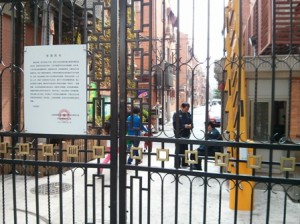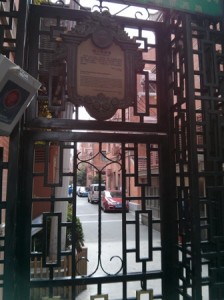Shanghai Street View: Giddy Gating

Shanghai residents who like to show their visiting friends some of the city’s better preserved traditional neighborhoods, known locally as shikumen, will be disappointed to hear that one of the best ones is now off the market. I’m referring to a recent clean-up of the shikumen neighborhood on West Nanjing Road near Shaanxi Lu, where a new gate has been installed to keep out everyone except local residents.
This kind of move is quite typical in Shanghai and throughout China, and at a broader level reflects the nation’s fascination with gates and fences that limit access to places. I don’t know the origin for this fascination, even though it does seem more prevalent on the mainland than in Hong Kong or Taiwan. But the result is always the same: even innocuous places like schools campuses and parks often restrict their access to two or three main entry points, giving them an almost prison-like feel.

The recent gating of the Nanjing Road shikumen neighborhood certainly wasn’t unexpected, since local authorities have been trying to clean up the area for several months now to improve life for local residents. The area had become rather commercial, and authorities worried it could follow a similar path to Tianzifang, the shopping and dining neighborhood that is wildly popular among tourists who make life noisy and inconvenient for local residents.
The cleanup on Nanjing Road began over the summer with the forced removal of the many boutique-style shops selling everything from tea to handicrafts from the ground floor units of many row houses. That was followed by this more formal gating, which means that now only people who actually live in the complex can enter.
The news report I read said the local authorities are still finalizing plans for the area, seeking to find a way to placate both local residents and outsiders who want to enjoy the old architecture and neighborhood feel. I certainly hope they will reopen the neighborhood on at least a limited basis, as it really is a nice contrast from all the high-end shops and malls on that part of Nanjing Road.
From a broader perspective, what happened in this neighborhood is a microcosm of the many changes taking place in China’s urban landscapes, and also reflects a national love affair with gated areas that I really think should be retired.
This kind of commercial development would never happen in a country like the US due to strict zoning laws that dictate what kinds of activity can take place in individual areas. An area like the shikumen neighborhood would have been labeled as residential in the West, formally banning commercial tenants from setting up shops and offices.
But of course this is 21st century China, where such zoning laws are a new concept and people set up shops and offices wherever they want until the police force them out. That reality creates a game of cat-and-mouse that often sees people open stores and restaurants wherever they can, and then race to do as much business as possible before eventually being forced out. So in that regard, this eviction of shops from the Nanjing Road neighborhood is a good thing and will restore some peace and quiet to the neighborhood.
But the gating of the area is the product of another mentality that really seems outdated. My guess is this fondness for restricting access to everything, from schools to parks and hospitals, is perhaps a product of the rise of massive work units that became widespread in the first 40 years of China’s post 1949 history. Those work units were massive compounds containing everything from schools to hospitals, factories and homes, and were often like fortresses with access limited to three or four guarded entry points.
I’ve always found it a bit strange how access to almost every major area within many Chinese cities is controlled in some way or another. Parks and school campuses in the west are usually broad, wide open spaces without any fences or gates, making them easily accessible for anyone. By comparison, most Chinese parks are carefully fenced and have strict operating hours. Schools are also tightly controlled to keep out everyone except students.
By keeping so many people out, this kind of fencing hurts development of community spirit by downplaying the idea that big open spaces should be enjoyed by everyone. In cases like this area on Nanjing Road, perhaps local officials could take the unprecedented step of not only removing the entry gate to this historic neighborhood, but also removing all the fences surrounding the area. Such openness could someday be replicated throughout the city, sending the signal that Shanghai is a place that welcomes outsiders and wants to make everyone feel at home when they are out and about.
